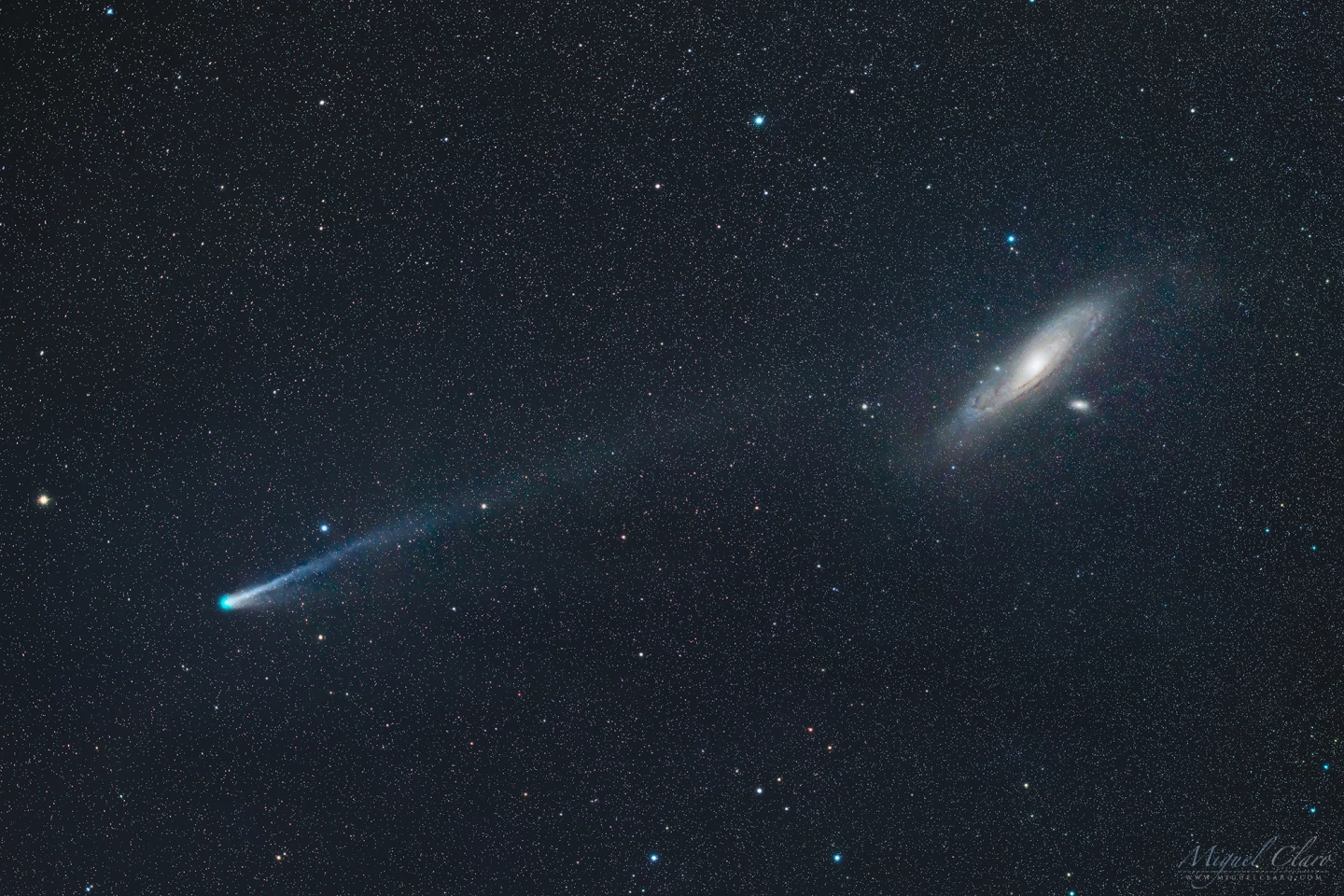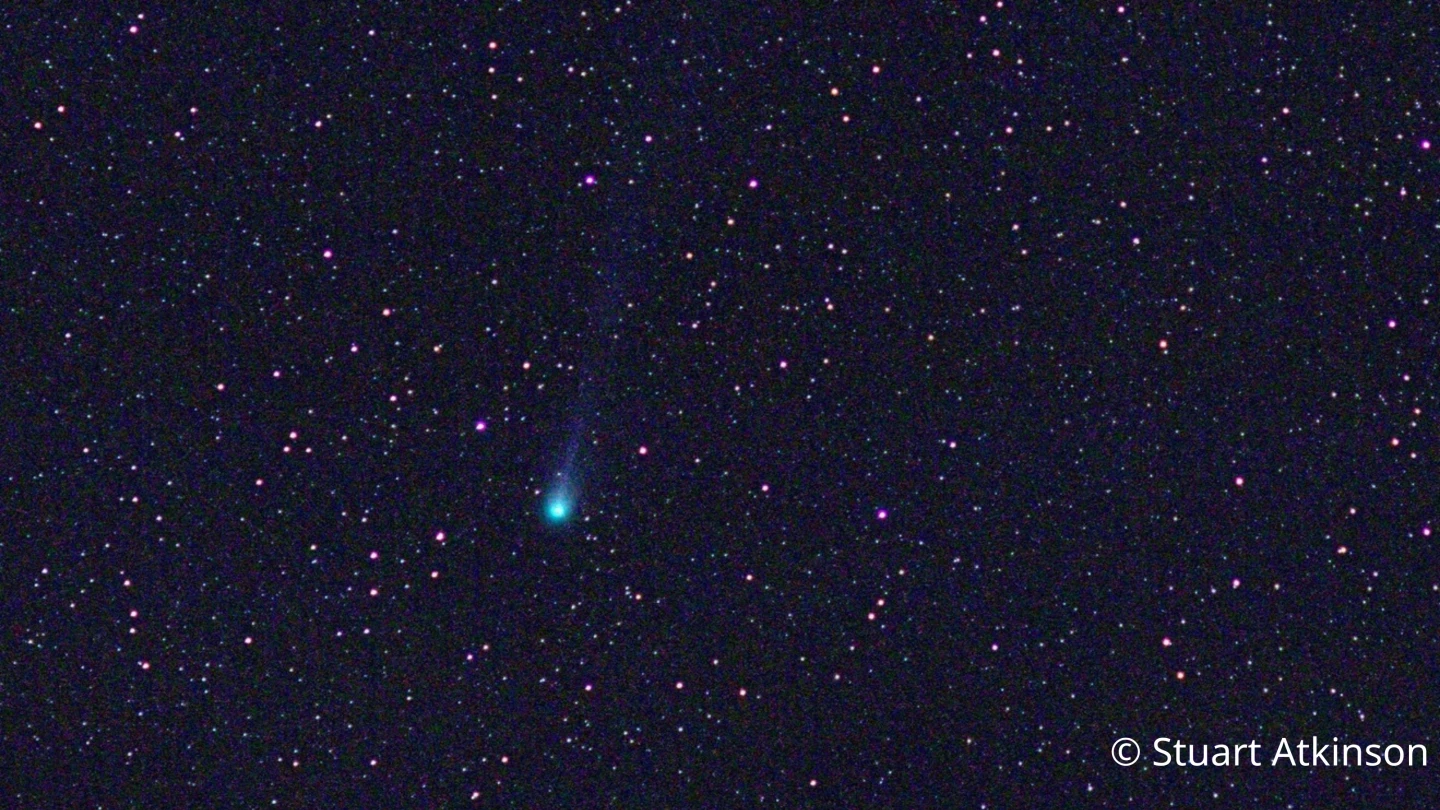A huge comet will grace our skies over the next few months, putting on a grand show through binoculars or telescopes, and will even be visible to the naked eye. So how and when can you see it?
Professor Jonti Horner from the Centre for Astrophysics at the University of Southern Queensland guides us through the best practices for Northern and Southern Hemisphere viewing. And this might be just the warm-up act for a brighter comet later in the year.Devils and dragons
The comet in question is officially designated 12P/Pons-Brooks, although you might hear mention of it in the media going by the catchy names of “The Devil Comet” or “Mother of Dragons.” The former nickname came from early photos where outbursts of activity made it appear to sport a pair of demonic horns, while the second was pitched by the European Space Agency because the comet is suspected to be the parent body of a small annual meteor shower called the kappa-Draconids.

12P/Pons-Brooks is a Halley-type comet, meaning it has an orbital period on the scale of decades. In this case, it returns to the inner solar system every 70 years – the last time it swung through our neighborhood was 1954, and if you miss it this time you’ll have to wait until 2094.
On this visit, it will make its closest pass to the Sun on April 21, 2024, before making its closest approach to Earth on June 2, when it will be about 232 million km (144 million miles) away. That’s not super close, but the large size of its “head” – about 30 km (18.6 miles) wide – means it should be relatively bright.How can you see it?
As with most stargazing, you’ll get the best results with the darkest skies you can find. That means getting out of the city and away from sources of light pollution, and choosing nights where the Moon is smaller or below the horizon.
While 12P/Pons-Brooks is technically visible to the naked eye, that isn’t necessarily the best way to view it, Horner told New Atlas. Whipping out a pair of binoculars or better yet, a telescope, will give you a clearer view.
“Seen with the naked eye, it will only ever really be a fuzzy blob – and a faint fuzzy blob at that,” Horner explained. “If you have really good eyesight, and are observing from a very dark site, you might be able to spot the comet's tail, pointing away from the Sun - but this is really a comet that has been excelling photographically. There are loads of amazing pictures on the internet already of the comet – it cruised past the Andromeda galaxy and the Triangulum spiral galaxy over the last few weeks, which was a wonderful photo opportunity.”

Regardless of where you are and when you look, 12P/Pons-Brooks will generally appear in the west, low near the horizon. At the time of writing (early April 2024), 12P/Pons-Brooks is located in the constellation of Aries, but of course this will change over time as it heads towards Orion. The best way to find it, Horner says, is to use planetarium apps like Stellarium, or websites like TheSkyLive.com, which provide live guides to what’s visible in the sky from your location.
“Current predictions suggest it will reach about magnitude 3.7 – that’s a bit fainter than the Andromeda galaxy, which is around magnitude 3.4,” Horner told us. “For most people, the Andromeda galaxy is a relatively easy thing to see in the Northern Hemisphere's autumn/winter sky (Southern Hemisphere spring/autumn), as a fuzzy blob - if you know where to look. The comet will be like that – a fuzzy blob you can spot, if you know where to look. If your eyesight is sharp enough, or you use binoculars (or a telescope), the comet's brightest part will be the head/coma, which will be the bit nearest the Sun in the sky. The tail will point away from the Sun – so if the comet is low in the western sky in the evening, the tail will point upwards from the horizon.”When can you see it?
The best dates to see comet 12P/Pons-Brooks will depend on where you are on Earth. The show starts in the Northern Hemisphere, where folks get to see it when the comet will be closest to the Sun and therefore at its brightest, but those in the Southern Hemisphere will be able to see it later, when it’s at its closest to Earth.
Northern Hemisphere
“For people in the Northern Hemisphere, the best time to see the comet is the next couple of weeks – it is heading south in the sky, and so is getting lower and lower in the western sky after sunset, such that, from mid-northern latitudes, it will be likely lost in the glare of twilight by late April,” Horner said.
“A really interesting opportunity for a fleeting glance of the comet will come during the total solar eclipse in [North America] on April 8 – for those who are watching the eclipse, and who get to see totality, they should be able to pick the comet up near Jupiter in the sky whilst watching the eclipse. The comet will be between Jupiter and the Sun in the sky - but closer to Jupiter than it is to the Sun!
“April 10 could be a great photo opportunity for those trying to get a glamour shot of the comet – as on that evening, it will be located quite close to the very thin crescent moon, and also near Jupiter – shining bright in the low western sky.”
Southern Hemisphere
“For observers in the Southern Hemisphere, we'll start to be able to spot the comet low in the western sky around mid-April – if you know where to look,” Horner explained. “It will be so low that you might need to use binoculars to see it, and it will only be visible after the Sun has well and truly set. So don't go looking before sunset – you’ll not be able to see the comet, and you'll risk damaging your eyesight if you end up looking at the Sun through the binoculars!
“The first couple of weeks of May are a really good time to look for the comet, low in the western sky after sunset, as the comet will be near the constellation Orion, which will be setting to the west in the evening sky. For the keen astrophotographers, this will be a great time to try to get some nice wide field images showing the comet's tail passing through Orion!
“For those southern observers, the comet will gradually get higher in the sky and easier to spot through May and into June, but it will be starting to fade by then. It will likely still be visible to the naked eye (just) in early June, when it is closest to Earth.”

Practice run
It turns out, 12P/Pons-Brooks might just be the warm-up act for an even more impressive comet that will swing past later this year, much closer to Earth at just 70 million km (44 million miles) away.
“The highlight for me is potentially comet 2023/A3 Tsuchinshan-ATLAS, which has the potential to be a really spectacular sight later in the year,” Horner told us. “That comet should become an easy naked eye target – much brighter than Pons-Brooks – and might even end up being really spectacular. The caution here is the old saying by David Levy: ‘Comets are like cats: they have tails, and they do precisely what they want.’ So this could be really amazing, but we won't know for sure 'til we get to see it.”
So far, the cards seem to be falling in a promising way, Horner says. Keep an eye out for this one in September and October 2024.General tips
If you’re interested in getting into stargazing, Horner says the best way is to find your local astronomy society. Cozying up to these enthusiasts is a great way to gain access to their knowledge (and equipment).
“That's a great way to learn more about astronomy in general, and they'll be able to give some great tips on where and when to look for the coolest things in the sky,” Horner told us. “Their members will also likely own their own telescopes, which will be their pride and joy – and they'll often be more than happy to show them off. Astronomy is an amazing hobby, but it is even better when it is a hobby shared – it's a great thing to do with other people.”







